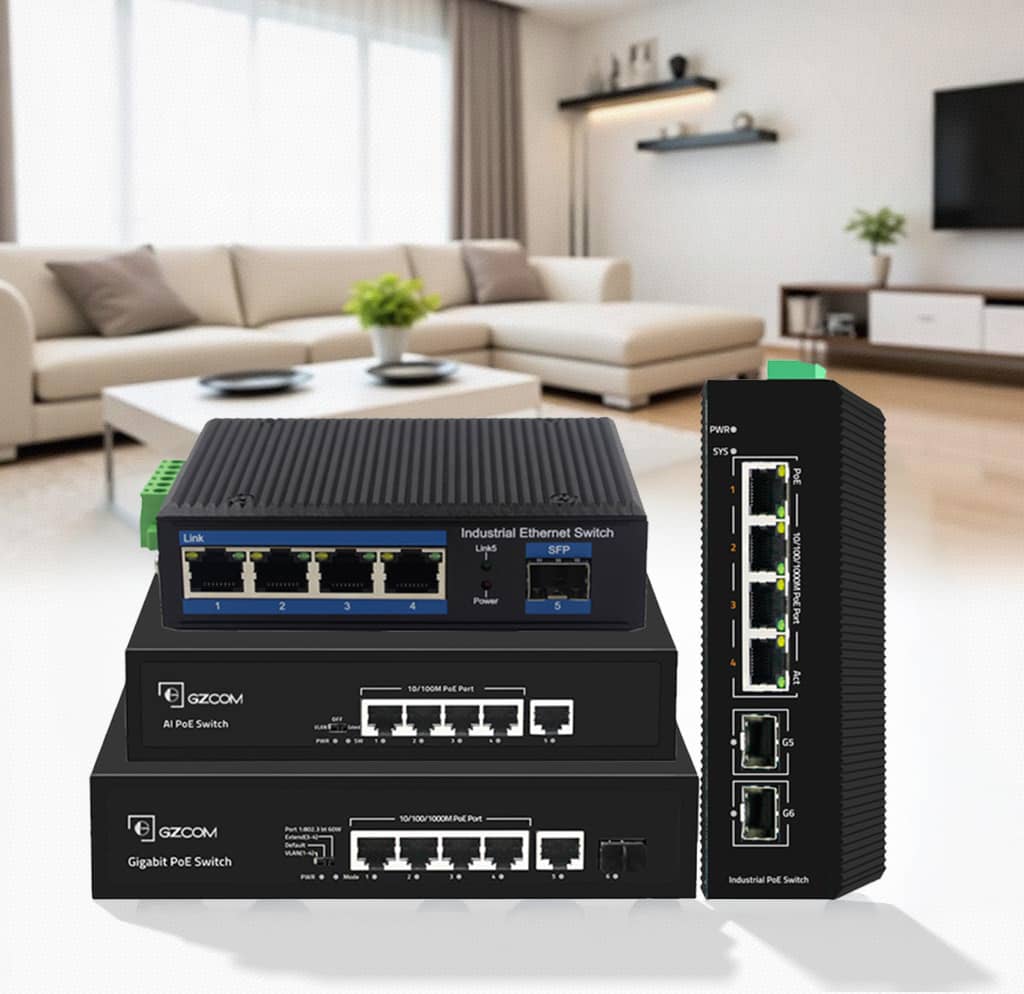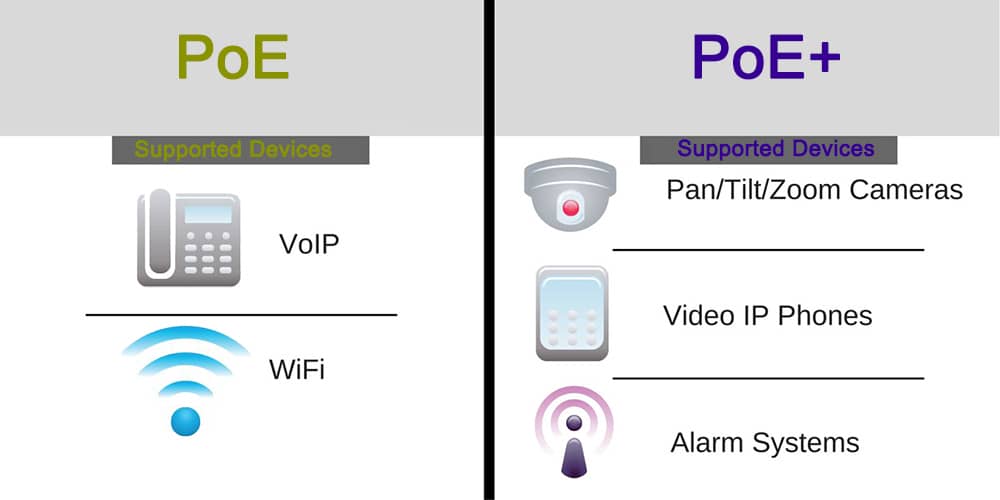Please submit your message online and we will contact you as soon as possible!
- Experience security and speed, without compromise.

2025-03-03
Choosing the right network switch can be challenging, especially when you're looking for a Power over Ethernet (PoE) solution. When it comes to smaller deployments, a 4 port PoE switch is often the perfect size. However, simply searching for a "4 port PoE switch" can lead to a vast array of options. Understanding the key differences between various 4 port PoE switch types is crucial to making an informed decision. This comprehensive comparison guide from GZCOM, your trusted networking partner, will break down the critical distinctions between unmanaged and managed switches, Gigabit and Fast Ethernet, PoE and PoE+, and more, empowering you to select the poe switch 4 port that best fits your specific networking needs.

When comparing 4 port PoE switches, several key factors differentiate the models and impact their suitability for different applications. Let's delve into these comparison points:
1. Unmanaged vs. Managed 4 Port PoE Switches
This is a primary distinction impacting both functionality and price.
Unmanaged 4 Port PoE Switches:
Simplicity: These switches are designed for plug-and-play operation. They require no configuration and are incredibly easy to use.
Functionality: Provide basic connectivity and PoE power. They lack advanced features like VLANs, QoS, or network monitoring.
Cost: Generally more affordable than managed switches.
Ideal For: Basic home networks, very small offices, simple IP camera setups, and users prioritizing ease of use and cost-effectiveness.
Managed 4 Port PoE Switches:
Control: Offer advanced features and control over your network through a web-based interface or command-line interface.
Functionality: Support VLANs (Virtual LANs) for network segmentation, QoS (Quality of Service) for traffic prioritization, SNMP for network monitoring, port mirroring for diagnostics, and enhanced security features.
Cost: Typically more expensive than unmanaged switches due to added features.
Ideal For: Small to medium-sized businesses, networks requiring VLANs for security or performance, VoIP networks needing QoS, and users wanting greater network control and monitoring.
2. Gigabit Ethernet vs. Fast Ethernet 4 Port PoE Switches
Network speed is a crucial factor, especially for bandwidth-intensive applications.
Fast Ethernet 4 Port PoE Switches:
Speed: Support network speeds up to 100 Mbps (Megabits per second).
Cost: Generally less expensive than Gigabit switches.
Suitable For: Basic internet browsing, standard definition IP cameras, and networks with low bandwidth demands.
Limitations: May bottleneck performance for HD video streaming, large file transfers, or high-speed wireless networks.
Gigabit Ethernet 4 Port PoE Switches:
Speed: Support network speeds up to 1000 Mbps (Gigabits per second). Significantly faster than Fast Ethernet.
Cost: Slightly more expensive than Fast Ethernet switches, but increasingly affordable.
Suitable For: Modern networks, HD and Ultra-HD IP cameras, high-speed wireless access points, bandwidth-intensive applications, and future-proofing your network.
Recommendation: For most modern applications, Gigabit 4 port PoE switches are highly recommended due to their superior performance and future-proof capabilities.
3. PoE (IEEE 802.3af) vs. PoE+ (IEEE 802.3at) 4 Port PoE Switches

Power output is critical to ensure compatibility with your PoE devices.
PoE (IEEE 802.3af) 4 Port Switches:
Power per Port: Provides up to 15.4 Watts of power per port.
Suitable For: Most standard PoE devices such as basic IP cameras, VoIP phones, and some wireless access points.
Limitations: May not provide enough power for devices with higher power requirements like PTZ cameras, advanced wireless access points, or PoE lighting.
PoE+ (IEEE 802.3at) 4 Port Switches:
Power per Port: Provides up to 30 Watts of power per port, nearly double the power of standard PoE.
Suitable For: Devices requiring higher power, including PTZ IP cameras, high-performance wireless access points, PoE lighting, and some industrial devices.
Recommendation: If you plan to power devices with higher power demands or want future-proofing for potentially higher-power devices, choose a PoE+ 4 port switch. Many GZCOM 4 port PoE switches offer PoE+ support.
GZCOM Offering: Check individual GZCOM 4 port PoE switch models for PoE/PoE+ specifications to match your power needs.
4. Industrial vs. Desktop 4 Port PoE Switches
The operating environment is a significant factor, especially for non-office deployments.
Desktop 4 Port PoE Switches:
Design: Designed for indoor, office-like environments with controlled temperatures and clean conditions. Typically made of plastic or lighter metal housings.
Operating Temperature: Standard operating temperature ranges, typically 0°C to 40°C (32°F to 104°F).
Suitable For: Home, office, and standard indoor deployments.
Design: Ruggedized and hardened for harsh environments. Features robust, often metal enclosures designed to withstand extreme temperatures, humidity, dust, vibrations, and electromagnetic interference.
Operating Temperature: Extended operating temperature ranges, often -40°C to +85°C
Suitable For: Industrial automation, outdoor deployments, harsh environments, warehouses, factories, transportation systems, and any application requiring robust performance in challenging conditions.
Choosing the "best" 4 port PoE switch isn't about one model being universally superior. It's about selecting the type that best aligns with your specific needs and application:
For Basic Home or Small Office Networks: An unmanaged Gigabit 4 port PoE switch (standard PoE or PoE+) often provides the best balance of simplicity, performance, and affordability.
For Networks Requiring Control & Security: A managed Gigabit 4 port PoE switch (PoE or PoE+) is essential to implement VLANs, QoS, and other management features.
For Bandwidth-Intensive Applications: Always opt for a Gigabit 4 port PoE switch to ensure smooth performance.
For High-Power Devices: Choose a PoE+ 4 port switch to provide sufficient power to devices like PTZ cameras or high-power wireless access points.
For Harsh Environments: An industrial 4 port PoE switch is crucial for reliable operation in extreme conditions.
Understanding the differences between 4 port PoE switch types is crucial for making an informed decision and building an efficient and reliable network. By carefully considering your specific needs and utilizing this comparison guide, you can confidently select the poe switch 4 port that perfectly matches your requirements and ensures optimal network performance. Trust GZCOM to provide you with the quality and variety you need in 4 port PoE switches.
Please submit your message online and we will contact you as soon as possible!